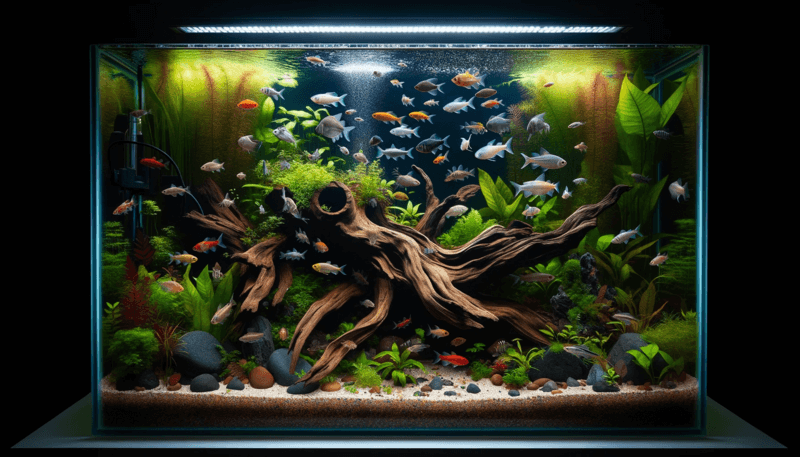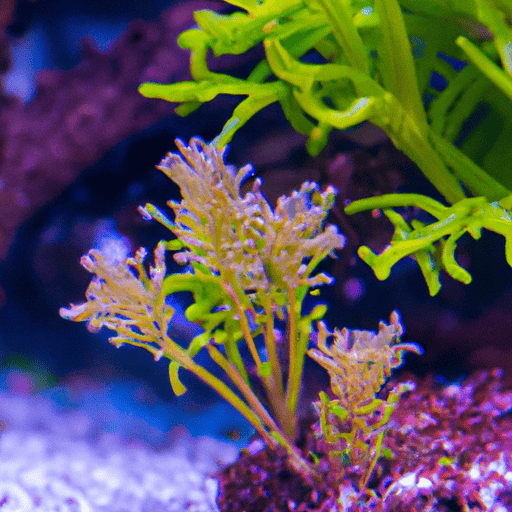If you’re looking to add some greenery to your aquarium or water feature, but don’t have a green thumb, fret not! There are plenty of easy-to-grow aquatic plants that even the most novice of gardeners can successfully cultivate. Whether you’re a beginner or simply seeking low-maintenance options, this article will provide you with a comprehensive list of hassle-free aquatic plants that are sure to thrive in your water-based environment. From vibrant green ferns to graceful floating lilies, you’ll soon discover a world of aquatic flora waiting to bring life and beauty to your aquatic haven. Aquatic plants are a great addition to any aquarium, not only for their beauty but also for the benefits they provide. Easy-to-grow aquatic plants are especially popular among beginners, as they require minimal maintenance and can thrive in a wide range of conditions. In this article, we will explore the various benefits of easy-to-grow aquatic plants, discuss how to choose the right ones for your aquarium, and provide a list of the top 10 easy-to-grow aquatic plants for beginners. We will also delve into the necessary care and maintenance for these plants, as well as common problems and troubleshooting tips.
Benefits of Easy-to-grow Aquatic Plants
Improved Water Quality
One of the significant benefits of having easy-to-grow aquatic plants in your aquarium is the improved water quality they provide. These plants absorb nitrates and other harmful compounds from the water, acting as natural filters. By doing so, they help in maintaining a healthy and balanced environment for the fish and other aquatic creatures. The plants also help in reducing algae growth by competing for nutrients, resulting in clearer and cleaner water.
Natural Habitat for Fish and Aquatic Creatures
Another advantage of having easy-to-grow aquatic plants in your aquarium is that they provide a natural habitat for fish and other aquatic creatures. The plants offer hiding spots and shelter, giving your fish a sense of security and reducing stress. Many species of fish also enjoy nibbling on the plants, providing them with a natural food source. Additionally, some aquatic plants release beneficial substances that promote the overall well-being of the fish and enhance their colors.
Oxygenation in the Aquarium
Easy-to-grow aquatic plants play a crucial role in oxygenating the aquarium water. Through the process of photosynthesis, these plants absorb carbon dioxide and release oxygen. This oxygenation is essential for the well-being of the fish and other inhabitants of the aquarium, as it helps maintain healthy oxygen levels and prevents oxygen deficiencies. Oxygenating plants also create a natural balance by reducing the risk of excessive carbon dioxide buildup.
Choosing the Right Easy-to-grow Aquatic Plants
Consider the Lighting Requirements
When selecting easy-to-grow aquatic plants for your aquarium, it is vital to consider their lighting requirements. Different plants have different needs when it comes to lighting intensity and duration. Some plants thrive in low-light conditions, making them suitable for aquariums with limited access to natural sunlight or low-intensity artificial lighting. On the other hand, certain plants require bright and direct light to photosynthesize effectively. Therefore, it is essential to assess the lighting conditions in your aquarium and choose plants that will thrive in those specific conditions.
Evaluate the Temperature Tolerance
Aquatic plants, like fish, have specific temperature requirements. It is crucial to evaluate the temperature tolerance of the plants you wish to add to your aquarium. Most easy-to-grow aquatic plants can adapt to a wide range of temperatures, but some may have specific preferences. Ensure that the plants you choose are compatible with the temperature range in which you maintain your aquarium. This will help them flourish and prevent any adverse effects on their growth and overall health.
Check the Nutrient Needs
Just like any other living organism, aquatic plants require certain nutrients to grow and thrive. When selecting easy-to-grow aquatic plants, it is essential to check their nutrient needs. Some plants have high nutrient requirements and may require additional fertilizers or specific substrate types to provide the necessary nutrients. On the other hand, some plants are more resilient and can thrive in nutrient-poor environments. Understanding the nutrient needs of the plants you choose will help you provide the ideal conditions for their growth and ensure their health and longevity.
Top 10 Easy-to-grow Aquatic Plants for Beginners
Java Fern (Microsorum pteropus)
Java Fern is a popular choice among beginners due to its hardy nature and adaptability to a wide range of conditions. It is a slow-growing plant that thrives in low to medium light conditions. It can be anchored to driftwood or rocks and adds a lovely touch of green to any aquarium.
Anubias (Anubias barteri)
Anubias is another easy-to-grow aquatic plant that is perfect for beginners. It is known for its dark green, broad leaves and can tolerate a wide range of lighting conditions. Anubias can be attached to rocks or driftwood, making it an excellent addition for aquascaping projects.
Amazon Sword (Echinodorus amazonicus)
The Amazon Sword is a popular and beautiful aquatic plant that is relatively easy to care for. It has long, green leaves and can grow quite large, making it a focal point in larger aquariums. This plant requires medium to high lighting and nutrient-rich substrate for optimal growth.
Hornwort (Ceratophyllum demersum)
Hornwort is an excellent choice for beginners due to its fast growth rate and low maintenance requirements. It is a floating plant that adds a beautiful green hue to the aquarium. Hornwort does not require substrate or specific lighting conditions and can adapt to a wide range of temperatures.
Java Moss (Taxiphyllum barbieri)
Java Moss is a versatile and easy-to-grow aquatic plant that can be attached to various surfaces in the aquarium, such as rocks or driftwood. It has a dense, bushy appearance and provides excellent cover for fish and fry. Java Moss thrives in low to medium light conditions and does not require additional CO2 injection.
Cryptocoryne (Cryptocoryne wendtii)
Cryptocoryne is a genus of aquatic plants that includes several species known for their ease of care. Cryptocoryne wendtii is one of the most popular varieties, with its vibrant green leaves and hardiness. It can thrive in low to medium light conditions and requires minimal maintenance.
Water Sprite (Ceratopteris thalictroides)
Water Sprite is a delicate and elegant aquatic plant that is suitable for beginners. It has finely divided leaves that create a lush and feathery appearance in the aquarium. Water Sprite is a fast grower and can adapt to a wide range of water conditions, making it an excellent choice for novice aquarists.
Dwarf Sagittaria (Sagittaria subulata)
Dwarf Sagittaria is a small and hardy aquatic plant that forms a dense carpet of grass-like leaves. It is ideal for creating a natural and vibrant foreground in the aquarium. Dwarf Sagittaria can tolerate a wide range of lighting conditions and does well in nutrient-rich substrates.
Vallisneria (Vallisneria americana)
Vallisneria is a genus of aquatic plants that includes several species, commonly known as “val.” Vallisneria americana is a popular choice among aquarists due to its long, tape-like leaves and ease of care. It requires moderate to high lighting and benefits from a nutrient-rich substrate.
Water Wisteria (Hygrophila difformis)
Water Wisteria is a versatile and fast-growing aquatic plant that is well-suited for beginners. It has feathery leaves that add a touch of elegance to any aquarium. Water Wisteria can adapt to various lighting conditions and does well in nutrient-rich substrates.
Caring for Easy-to-grow Aquatic Plants
Proper Lighting
Proper lighting is essential for the health and growth of easy-to-grow aquatic plants. Most of these plants thrive in low to medium light conditions, but their specific lighting requirements may vary. It is crucial to provide the right amount and intensity of light to support their photosynthesis process. Assess the lighting conditions in your aquarium and adjust as necessary. Consider using LED lights specifically designed for planted aquariums, as they provide optimal spectrum and intensity for plant growth.
Regular Water Changes
Regular water changes are crucial for maintaining the overall health of your aquarium, including the well-being of the easy-to-grow aquatic plants. Water changes help remove accumulated toxins and excess nutrients, preventing algae overgrowth and maintaining a healthy balance. Aim to change approximately 10-20% of the water in your aquarium every week. Be sure to dechlorinate the new water before adding it to the tank.
Nutrient Supplements
While easy-to-grow aquatic plants are generally resilient and do not require excessive nutrient supplementation, providing some additional nutrients can help boost their growth and overall health. Consider using liquid or root tab fertilizers specifically formulated for aquarium plants. These supplements provide essential nutrients such as nitrogen, phosphorus, and potassium, which are necessary for healthy plant growth. Follow the manufacturer’s instructions for dosing and frequency of application.
Pruning and Trimming
Regular pruning and trimming are necessary for maintaining the shape and appearance of your easy-to-grow aquatic plants. As these plants grow, they may become overgrown or develop dead or decaying leaves. By trimming and removing excess foliage, you can promote healthy growth and prevent the accumulation of debris in the aquarium. Use sharp, clean scissors or aquascaping tools to trim the plants, ensuring minimal disruption to the aquarium’s ecosystem.
Common Problems and Troubleshooting
Algae Overgrowth
Algae overgrowth is a common problem in aquariums, and easy-to-grow aquatic plants can help combat it to some extent. However, if you notice excessive algae growth in your tank, it may indicate an imbalance in the aquarium’s ecosystem. Consider evaluating factors such as lighting intensity, nutrient levels, and water quality. Adjust these factors as necessary to restore balance. Additionally, manual removal of excessive algae and reducing the duration of light exposure can help control algae growth.
Wilting or Yellowing Leaves
Wilting or yellowing leaves in easy-to-grow aquatic plants can indicate various issues, including nutrient deficiencies, inadequate lighting, or poor water conditions. Check the nutrient levels in your aquarium and ensure that the plants are receiving an adequate supply of essential nutrients. Assess the lighting conditions and adjust as necessary to provide the appropriate amount of light. Monitor water parameters such as pH, temperature, and ammonia levels to ensure optimal conditions for plant growth.
Rotting Roots
Rotting roots can be a result of poor water circulation or excessive substrate moisture. Insufficient oxygenation in the substrate can lead to root rot in easy-to-grow aquatic plants. Ensure proper filtration and water circulation in the aquarium to prevent stagnant areas. Avoid overwatering the substrate and provide adequate drainage to maintain the right moisture level. If you notice rotting roots, trim the affected portions and consider improving water circulation and substrate conditions.
In conclusion, easy-to-grow aquatic plants offer numerous benefits, including improved water quality, a natural habitat for fish and other aquatic creatures, and oxygenation in the aquarium. By carefully choosing the right plants based on their lighting requirements, temperature tolerance, and nutrient needs, beginners can set up a thriving aquatic ecosystem. The top 10 easy-to-grow aquatic plants mentioned in this article provide a range of options for novice aquarists. Proper care and maintenance, including providing adequate lighting, regular water changes, nutrient supplementation, and pruning, will ensure the health and longevity of these plants. By addressing common problems such as algae overgrowth, wilting or yellowing leaves, and rotting roots, beginners can troubleshoot and maintain a vibrant and flourishing aquarium. So, dive into the world of easy-to-grow aquatic plants and experience the wonders they can bring to your underwater oasis!





